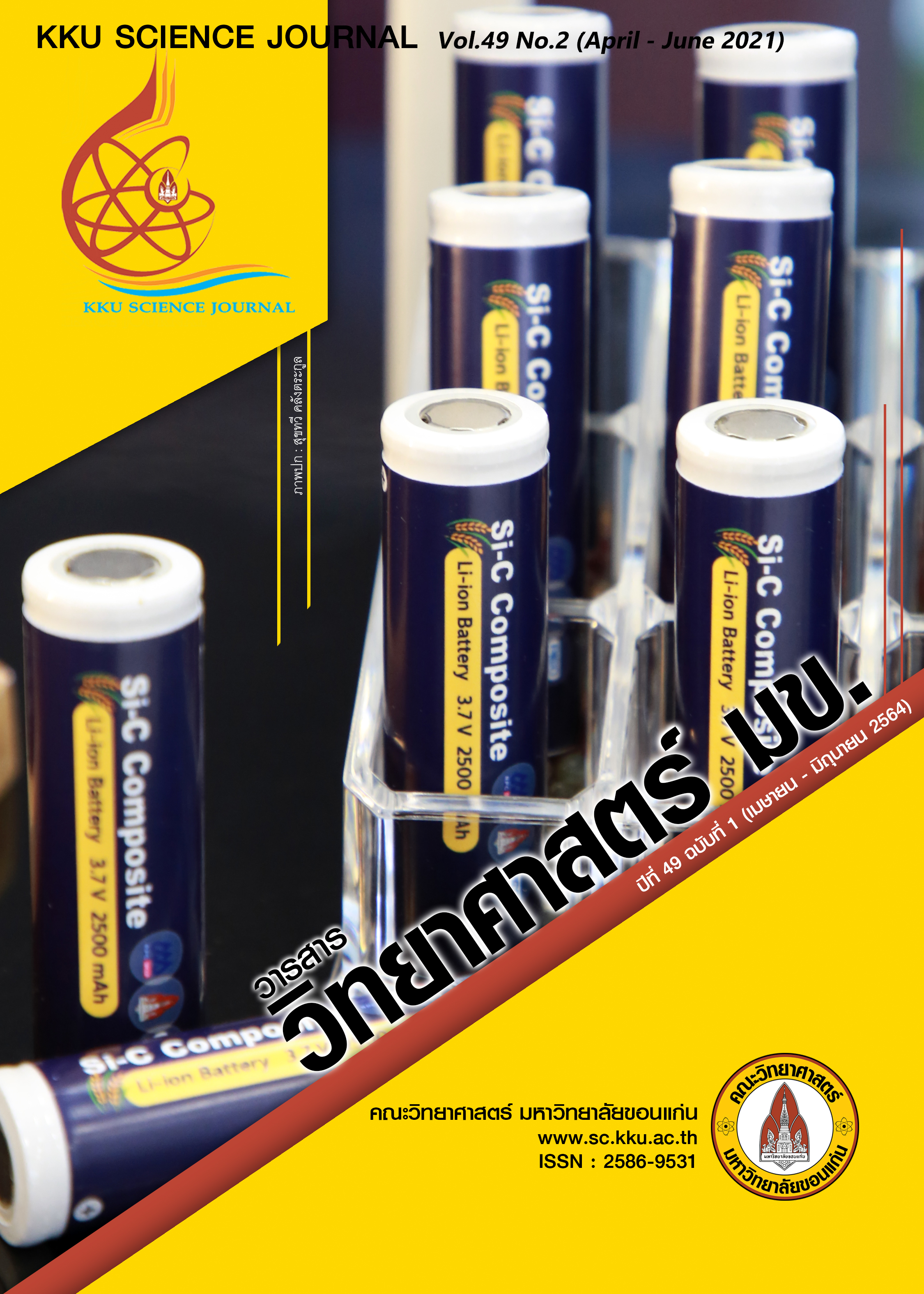การหาสภาวะที่เหมาะสมของการสกัดสารออกฤทธิ์ทางชีวภาพจากดอกอัญชัน ด้วยไมโครเวฟ
Main Article Content
บทคัดย่อ
อัญชัน (Clitoria termatea Linn.) มีสารแอนโทไซยานินที่มีฤทธิ์ต้านอนุมูลอิสระ สารสกัดจากดอกอัญชันถูกใช้เป็นส่วนผสมหรือเสริมในผลิตภัณฑ์อาหาร การสกัดด้วยไมโครเวฟ (MWA) เป็นวิธีสกัดที่มีประสิทธิภาพช่วยลดเวลาการสกัดและคงฤทธิ์ต้านอนุมูลอิสระได้วัตถุประสงค์ของงานวิจัยนี้เพื่อคัดเลือกสภาวะที่เหมาะสมในการสกัดสารออกฤทธิ์ทางชีวภาพจากดอกอัญชัน โดยใช้กำลังของไมโครเวฟ (MWA) 3 ระดับ ได้แก่ 150 450 และ 750 วัตต์ (W) และ 3 ระดับของระยะเวลาในการสกัด ได้แก่ 3 5 และ 10 นาที เปรียบเทียบวิธีการสกัดระหว่างวิธีการสกัดด้วยไมโครเวฟ วิธีการสกัดแบบดั้งเดิม (90 องศาเซลเซียส 2 ชั่วโมง) และวิธีการสกัดด้วยอัลตราโซนิกส์ ผลการทดลองพบว่าการสกัดด้วยไมโครเวฟที่ 150 วัตต์ เวลา 10 นาที มีปริมาณฟีนอลิกทั้งหมดสูงสุด (44.27 ± 0.977 mg/100g) และฤทธิ์ในการต้านอนุมูลอิสระ โดยวิธี ABTS assay สูงสุด (77.88 ± 0.92 mg/100g) (p<0.05) การสกัดด้วยไมโครเวฟที่ 750 วัตต์ เวลา 5 นาที พบว่ามีค่าร้อยละการยับยั้งสูงสุดเท่ากับ 13.37 ± 0.34 โดยวิธี DPPH (p<0.05) การสกัดด้วยไมโครเวฟเวลาการสกัดได้ 91.67% เมื่อเทียบกับการสกัดด้วยวิธีดั้งเดิม ดังนั้นการสกัดด้วยไมโครเวฟที่ 150 วัตต์ เวลา 10 นาที เป็นสภาวะที่เหมาะสม และเป็นแนวทางเลือกในการสกัดดอกอัญชันที่มีศักยภาพ
Article Details

This work is licensed under a Creative Commons Attribution-NonCommercial-NoDerivatives 4.0 International License.
References
กาญจนา นาคประสม หยาดฝน ทนงการกิจ ภานาถ แสงเจริญรัตน์ และ นักรบ นาคประสม. (2562). การหาสภาวะที่เหมาะสมในการสกัดสารฟีนอลิกทั้งหมดจากเมล็ดลำไยโดยวิธีไมโครเวฟร่วม. วิทยาศาสตร์บูรพา 24(1): 48-63.
ดวงกมล เรือนงาม. (2557). การสกัดสารต้านอนุมูลอิสระ. วารสารวิทยาศาสตร์ลาดกระบัง 23(2): 120-139.
น้ำอ้อย บุญมาก และ บุณยกฤต รัตนพันธุ์. (2561). ผลของกำลังไฟฟ้าและเวลาต่อการสกัดสารต้านอนุมูลอิสระจากกากกาแฟโดยเครื่องไมโครเวฟ. รายงานการประชุมวิชาการระดับชาติ ครั้งที่ 5 มหาวิทยาลัยราชภัฏกำแพงเพชร. 674-679.
บุหรัน พันธุ์สวรรค์. (2556). อนุมูลอิสระ สารต้านอนุมูลอิสระ และการวิเคราะห์ฤทธิ์ต้านอนุมูลอิสระ. วารสารวิทยาศาสตร์และเทคโนโลยี 21(3): 275-286.
วีรยา ศักดิ์คำดวง นันทิยา วงศ์แสงตา และอรุณศรี ปรีเปรม. (2552). สารจากดอกอัญชัน: องค์ประกอบทางเคมีและฤทธิ์. วารสาร ศูนย์บริการวิชาการ มหาวิทยาลัยขอนแก่น 17(1-4): 10-15.
ศุกฤชชญา เหมะธุลิน สุภาพร โสภาจร และอินธิวา ศรีพันรมย์. (2558). ผลิตภัณฑ์เครื่องดื่มชนิดเข้มข้นเพื่อสุขภาพจากดอกไม่หลากสี. แก่นเกษตร 43(1): 305-310.
อารีรัตน์ ซื่อดี. (2560). การใช้คลื่นไมโครเวฟสกัดสารสำคัญจากพืชสมุนไพร. วารสารวิชาการมหาวิทยาลัยอีสเทิร์นเอเชีย: ฉบับวิทยาศาสตร์และเทคโนโลยี 11(1): 1-14.
เอนก หาลี และบุณยกฤต รัตนพันธุ์. (2560). การศึกษาประสิทธิภาพในการต้านอนุมูลอิสระจากพืชผักสมุนไพรพื้นบ้าน 15 ชนิด. วารสารวิจัยและพัฒนา มจธ. 40(2): 283 – 293.
AOAC. (2000). Official methods of analysis of AOAC. International 17th edition; Gaithersburg, MD, USA Association of Analytical Communities.
Boulekbache-Makhlouf, L., Medouni, L., Medouni-Adar, S., Arkoub, L. and Madani, K. (2013). Effect of solvents extraction on phenolics content and antioxidant activity of the byproduct of eggplant. Industrial Crops and Products 49: 668-674.
Came, V. (2000). Microwave-assisted solvent extraction of environmentral samples. TrAC Trends in Analytical Chemistry 19(4): 229-248.
Do, Q. D., Angkawijaya, A. E., Tran-Nguyen, P. L., Huynh, L. H., Soetaredjo, F. E., Ismadji, S. and Ju, Y. H. (2014). Effect of extraction solvent on total phenol content, total flavonoid content, and antioxidant activity of Limnophila aromatica. Journal of Food and Drug Analysis 22(3): 296-302.
Kazuma, K., Noda, N. and Suzuki, M. (2003). Flavonoid composition related to petal color in different lines of Clitoria ternatea. Phytochemistry 64(6): 1133-1139.
Makasana, J., Dholakiya, B. Z., Gajbhiye, N. A. and Raju, S.. (2017). Extractive determination of bioactive flavonoids from butterfly pea (Clitoria ternatea Linn.). Research on Chemical Intermediates 43(2): 783-799.
Mehmood, A., Ishaq, M., Zhao, L., Yaqoob, S., Safdar, B., Nadeem, M., Munir, M., Wang, C. (2019). Impact of ultrasound and conventional extraction techniques on bioactive compounds and biological activities of blue butterfly pea flower (Clitoria ternatea L.). Ultrasonics Sonochemistry 51: 12-19.
Muhammad Ezzudin, R. and Rabeta, M.S.. (2018). A potential of Telang tree (Clitoria ternatea) in human health. Journal of Food Science 2: 415-420.
Prommajak, T., Surawang, S., & Rattanapanone, N. (2014). Ultrasonic-assisted extraction of phenolic and antioxidative compounds from lizard tail (Houttuynia cordata Thunb.). Songklanakarin Journal of Science and Technology 36: 65-72.
Qin, C., Li, Y., Niu, W., Ding, Y., Zhang, R., Shang, X. (2010). Analysis and characterisation of anthocyanins in mulberry fruit. Czech Journal of Food Sciences 28(2): 117-126.
Routray, W. and Orsat, V. (2014). MAE of phenolic compounds from blueberry leaves and comparison with other extraction methods. Industrial Crops and Products 58: 36-45.
Sinha, K., Sah, PD., Ramya, V., Datta, S. (2012). Improved extraction of natural blue dye from butterfly pea using microwave assisted methodology to reduce the effect of synthetic blue dye. International Journal of Chemical Technology 4(2): 57-65.
Singh, K., Simapaisan, P. and Utama-ang, N. (2017). Effect of microwave-assisted extraction on curcuminoid from turmeric and application in germinate-coated rice. Food and Applied Bioscience Journal 5(1): 11-22.

